Crassula tetragona
Crassula tetragona L.
Family: Crassulaceae
Common names: kerkei, miniature pine tree, mini pine (Eng.); karkai (Afr.)
Introduction
An attractive, hardy, evergreen succulent plant with a compact upright habit, dark green, sword-shaped leaves that curve upwards and creamy white flowers. These are usually bold accent plants to be shown off and are rewarding container plants.
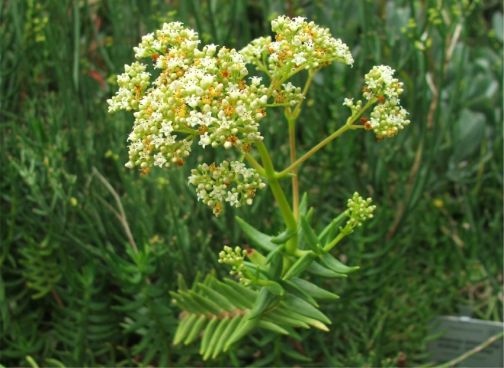
Description
Description
Crassula tetragona is an evergreen shrub with narrow, almost needle-like foliage that grows into a sturdy, neatly shaped bush. It is an erect or spreading shrublet to 1 m, with a woody stem covered in brown bark. The leaves are in opposite pairs, lance-shaped with upward pointing tips. It bears masses of tiny, creamy white flowers in flat-topped clusters in late spring and summer. The flowers turn orange as they fade.
Six subspecies of Crassula tetragona are recognised:
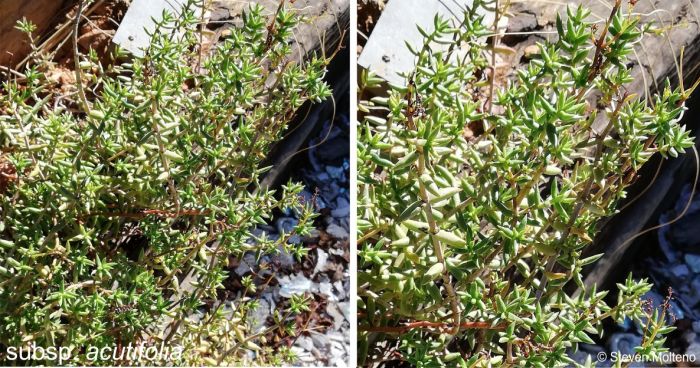
subspecies acutifolia, a decumbent, carpet-forming shrublet up to 150 mm tall, leaves 5-15 x 1-2 mm, inflorescense irregularly branched in late summer, growing in low Karoo vegetation in the Western and Eastern Cape.
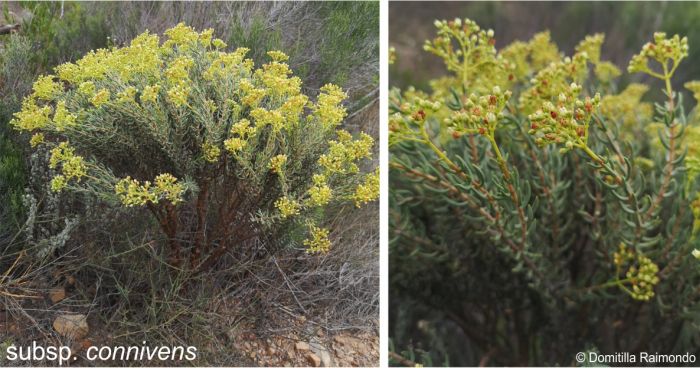
subspecies connivens, a stiffly upright shrublet with upward-pointing branches up to 1 m tall, leaves 18-27 x 1-2 mm, ascending, inflorescence round-topped with indisctinct peduncle in autumn, growing on north-facing sandstone ridges in the Little Karoo.
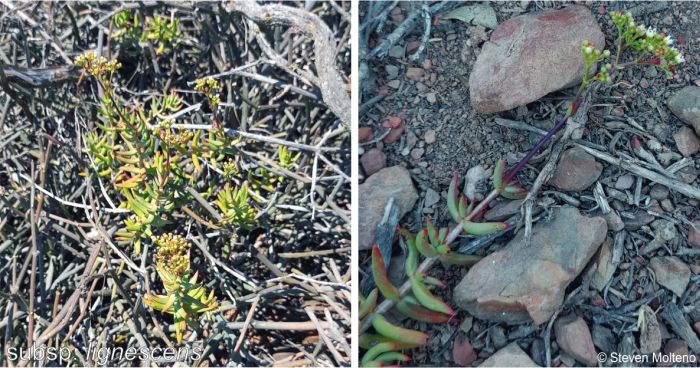
subspecies lignescens, an upright or scrambling shrublet to 800 mm with woody branches and flaking bark, leaves 12-20 x 2-3 mm, inflorescence round-topped, many-flowered, from midsummer to autumn, the most common subspecies growing in karroid scrub in the Northern, Western and Eastern Cape.

subspecies robusta, a robust, upright, shrubby succulent usually about 500 mm but up to 1 m, leaves 20-30 x 3-5 mm with blunt tips, inflorescence round-topped in late summer, grows in scrub in sheltered valleys in the Eastern Cape.
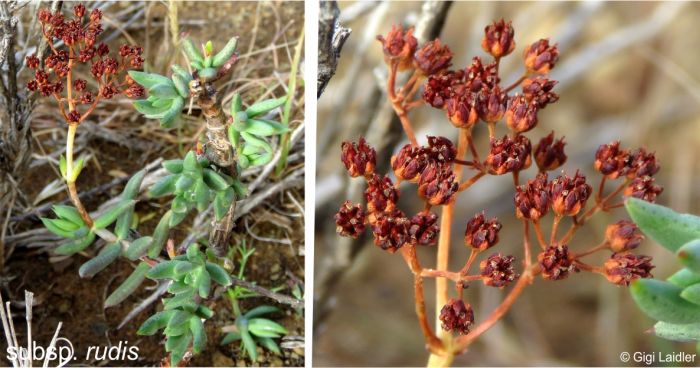
subspecies rudis, an upright, sparsely branched shrub to 250 mm tall, leaves 8-25 x 2-3 mm, inflorescence irregularly branched, from midsummer to autumn, growing under other shrubs on rocky slopes in succulent vegetation in the Northern and Western Cape.
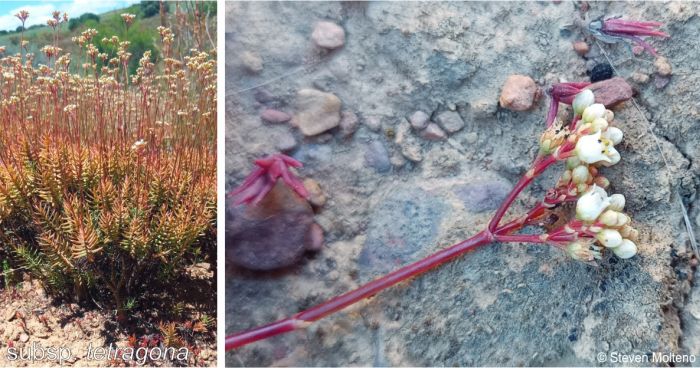
subspecies tetragona, succulent shrubs, upright or prostrate with erect tips, 100-200 mm tall, leaves 10-25 x 2-3 mm, inflorescence a dense flat-topped cluster of tiny cream to white flowers on a long peduncle from midsummer to autumn, growing in dry vegetation in the Northern, Western and Eastern Cape provinces.
Conservation Status
Status
Crassula tetragona is not threatened, it is assessed as Least Concern (LC).
Distribution and habitat
Distribution description
This species is native to South Africa and has a widespread distribution. It occurs from the Orange River in Namaqualand in the Northern Cape to Worcester in the Western Cape to beyond the Kei River and Grahamstown in the Eastern Cape province. The plants are normally found growing among rocks, on koppies, on rocky slopes, often on north-facing slopes, in dry fynbos and renosterveld, succulent karoo and scrub.
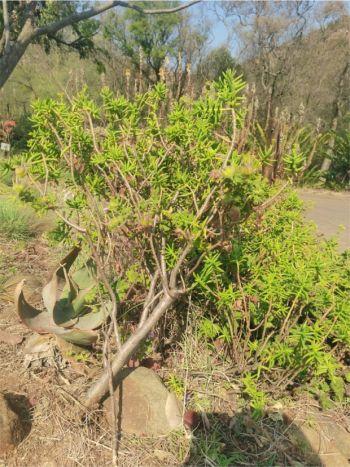
Derivation of name and historical aspects
History
The name Crassula is Latin and is the diminutive of crassus, which means ‘thick’, referring to the fleshy nature of all crassulas. This genus was first named in 1862 and the genus contains 150-200 species, most of them occurring in South Africa. The species name tetragona is also Latin and means ‘with four sides’ and describes the arrangement of the leaves. It is most commonly called miniature pine tree among plant fanatics, for its popular use as a pine-like bonsai.

Ecology
Ecology
Crassula tetragona bears masses of tiny creamy white flowers in an inflorescence on top of the shrub, which attracts many insects. Its succulent leaves and stems enable it to store water and survive periods of drought.
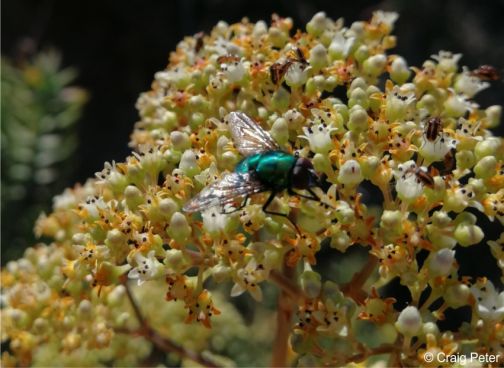
Uses
Use
Crassula tetragona can be planted as a low informal hedge in frost-free areas and makes a fantastic addition to a succulent combination planter as well. The plants often used as ornamentals in succulent rockery gardens, retaining walls, grassland gardens and it is good plant for containers or pots. According to Thunberg, the species was used as a medicinal plant, a handful of leaves boiled in milk, was used as a remedy for diarrhea.
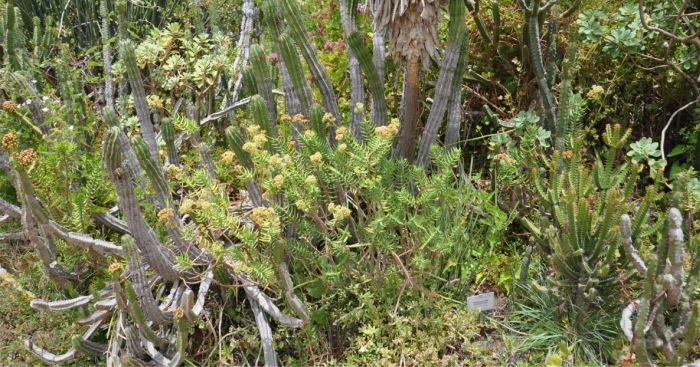
Growing Crassula tetragona
Grow
It is very easy to propagate, and propagation can be done through stem cuttings and leaf cuttings. After collecting a stem cutting let it dry for a day or two, it does not take long to dry because they are thin. Make sure the cutting is 5-7cm long. Dipping the cutting in a rooting hormone is optional. Once the cut has dried and healed, plant the cutting in a well-drained potting mix. Keep the cutting away from direct sunlight and water the soil every few days when it feels dry. The plant will be fully rooted after about 4-6 weeks and new growth will develop from the top side along the stem.
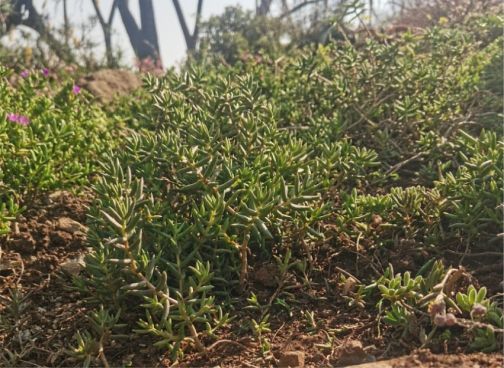
New plants can be planted out within few weeks of being rooted. Plant them in well-drained soil in a full sun or semi-shaded position that is out of the way of strong winds as the leaves and stems will not withstand constant bashing of the wind because they are fragile and are broken off easily. Although succulents can survive without fertilizers, one can apply them to improve their growth and overall health, but they can only be applied during its growing season or in spring. Occasionally the species may suffer from mealy bug and over watering or poor drainage may cause root rot.
References
- International Crassulaceae Network. Crassula tetragona. https://www.crassulaceae.ch/de/artikel?akID=31&aaID=2&aiID=T&aID=3110. Accessed 27/10/2023.
- Laidler, G. 2018. Observation of Crassula tetragona ssp. rudis, Muggefontein WC. https://www.inaturalist.org/observations/14714426.
- Manning, J. & Goldblatt, P. 2012. Plants of the Greater Cape Floristic Region 1: the Core Cape Flora. Strelitzia 29. South African National Biodiversity Institute, Pretoria.
- Molteno, S. 2019. Image of Crassula tetragona subspecies acutifolia - Babylonstoren. https://commons.wikimedia.org/wiki/File:Crassula_tetragona_acutifolia_-_Babylonstoren.jpg.
- Molteno, S. 2021. Observation of Crassula tetragona ssp. lignescens, Bruintjiesrivier, WC. https://www.inaturalist.org/observations/155296534.
- Molteno, S. 2022. Observation of Crassula tetragona ssp. tetragona, Cape Winelands, WC. https://www.inaturalist.org/observations/104340488.
- Peter, C. 2018. Observation of Crassula tetragona ssp. robusta, Makana EC. https://www.inaturalist.org/observations/17909390
- Raimondo, D., Von Staden, L., Foden, W., Victor, J.E., Helme, N.A., Turner, R.C., Kamundi, D.A. & Manyama, P.A. (eds) 2009. Red list of South African plants. Strelitzia 25. South African National Biodiversity Institute, Pretoria.
- Raimondo, D. 2021. Observation of Crassula tetragona ssp. connivens, Eden, WC. https://www.inaturalist.org/observations/72921218.
- Smith, C.A. 1966. Common names of South African plants. Memoirs of the Botanical Survey of South Africa No. 35. Government Printer, Pretoria.
- Tölken, H.R. 1977. A revision of the genus Crassula in southern Africa. Contributions from the Bolus Herbarium No.8. Bolus Herbarium, University of Cape Town.
- Tölken, H.R. 1985. Crassulaceae. Flora of Southern Africa 14: 1–229.
- Voigt, W. 2005. Crassula multicava Lem. (Crassulaceae). PlantZAfrica. Online. http://pza.sanbi.org/crassula-multicava.
- Wikipedia, Crassula tetragona. https://en.wikipedia.org/wiki/Crassula_tetragona. Accessed 06/09/2023.
Credits
Thato Moeketsane
Walter Sisulu National Botanical Garden
and Alice Notten
Kirstenbosch National Botanical Garden
October 2023
Acknowledgements: the authors thank Steven Molteno, Gigi Laidler, Domitilla Raimondo and Craig Peter for making their images available via iNaturalist.
Plant Attributes:
Plant Type: Shrub, Succulent
SA Distribution: Eastern Cape, Northern Cape, Western Cape
Soil type: Sandy, Loam
Flowering season: Early Summer, Late Summer, Autumn
PH: Acid, Neutral
Flower colour: White, Cream
Aspect: Full Sun, Morning Sun (Semi Shade), Afternoon Sun (Semi Shade)
Gardening skill: Easy
Special Features:
Horticultural zones











Rate this article
Article well written and informative
Rate this plant
Is this an interesting plant?
Login to add your Comment
Back to topNot registered yet? Click here to register.